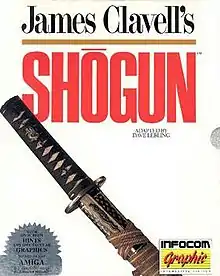James Clavell's Shōgun
James Clavell's Shōgun is an interactive fiction computer game written by Dave Lebling and released by Infocom in 1989. Like most of Infocom's games, it was released for several popular computer platforms of the time, such as the Apple II and PC. As the title indicates, the game is based on the 1975 novel Shōgun by James Clavell. It is Infocom's thirty-third game.
| James Clavell's Shōgun | |
|---|---|
 James Clavell's Shōgun cover art | |
| Developer(s) | Infocom |
| Publisher(s) | Infocom |
| Designer(s) | Dave Lebling |
| Artist(s) | Donald Langosy |
| Engine | ZIL |
| Platform(s) | Amiga, Apple II, MS-DOS, Macintosh |
| Release | Macintosh: March 14, 1989
Amiga: March 21, 1989 Apple II: May 10, 1989 DOS: July 6, 1989 |
| Genre(s) | Interactive fiction |
| Mode(s) | Single-player |
Plot
The game reproduces many of the novel's scenes, few of which are interconnected in any way. The player assumes the role of John Blackthorne, pilot-major of the Dutch trading ship Erasmus. During a voyage in the Pacific Ocean in the year 1600, the Erasmus is shipwrecked in Japan. Blackthorne must survive in a land where every custom is as unfamiliar to him as the language. After learning some of the society's ways, he is drawn into a political struggle between warlords and falls in love with a Japanese woman. Eventually he embraces Japanese life and is honored as a samurai.
Feelies
Infocom continued its tradition of feelies, or extra items included in the game package. The feelies included with Shōgun were a map representing John Blackthorne's "known world" of 1600, and The Soul of the Samurai, a booklet describing the history and significance of samurai swords.
Notes
By 1989, Infocom no longer categorized its games according to estimated difficulty level. Shōgun could be said to fall anywhere from Infocom's former "Standard" level to "Expert". Players who are intimately familiar with the novel, of course, may find the game to be much easier than those who have not read the book.
Shōgun features several illustrations in the style of Japanese Ukiyo-e woodcuts. While graphics of any kind were disdained in Infocom's early years, four of their final games included at least incidental illustrations and images.
In sharp contrast to Douglas Adams' close work with Steve Meretzky on Infocom's The Hitchhiker's Guide to the Galaxy game, James Clavell contributed little to the design of the game, although he and Dave Lebling met several times. He treated the game as a traditional licensing agreement rather than a collaboration.[1] Consequently, the game contains many scenes from the novel presented verbatim or made thinly interactive.
Dave Lebling has said that he considers Shōgun the worst game he was ever responsible for overall, although he is proud of several of the timing puzzles.[2]
Reception
Dave Arneson gave Shōgun a negative review in Computer Gaming World. He wrote that the linear nature of the game and poor hints contributed to guess-the-verb and trial-and-error gameplay, and that the illustrations—while "nice to look at"—did not provide information to play the game. Arneson praised the game's large size, but concluded that Shōgun was only "mildly interesting" and inferior to Zork Zero.[3]
References
- http://waxy.org/2008/04/milliways_infocoms_unreleased_sequel_to_hitchhikers_guide_to_the_galax/#comment-1650044
- Granade, Stephen; Philip Jong (22 July 2001). "Dave Lebling Interview". Adventure Classic Gaming. Retrieved 31 May 2013.
- Arneson, Dave (August 1989). "Shōgun". Computer Gaming World. pp. 12–13. Retrieved 4 November 2013.
External links
- Shōgun at MobyGames
- James Clavell's Shōgun at The Visual Novel Database
- James Clavell's Shōgun can be played for free in the browser at the Internet Archive
- Game information and overview at Peter Scheyen's Infocom website
- Infocom-if.org's entry for Shōgun
- The Infocom Bugs List entry for Shōgun
- Review in Games International